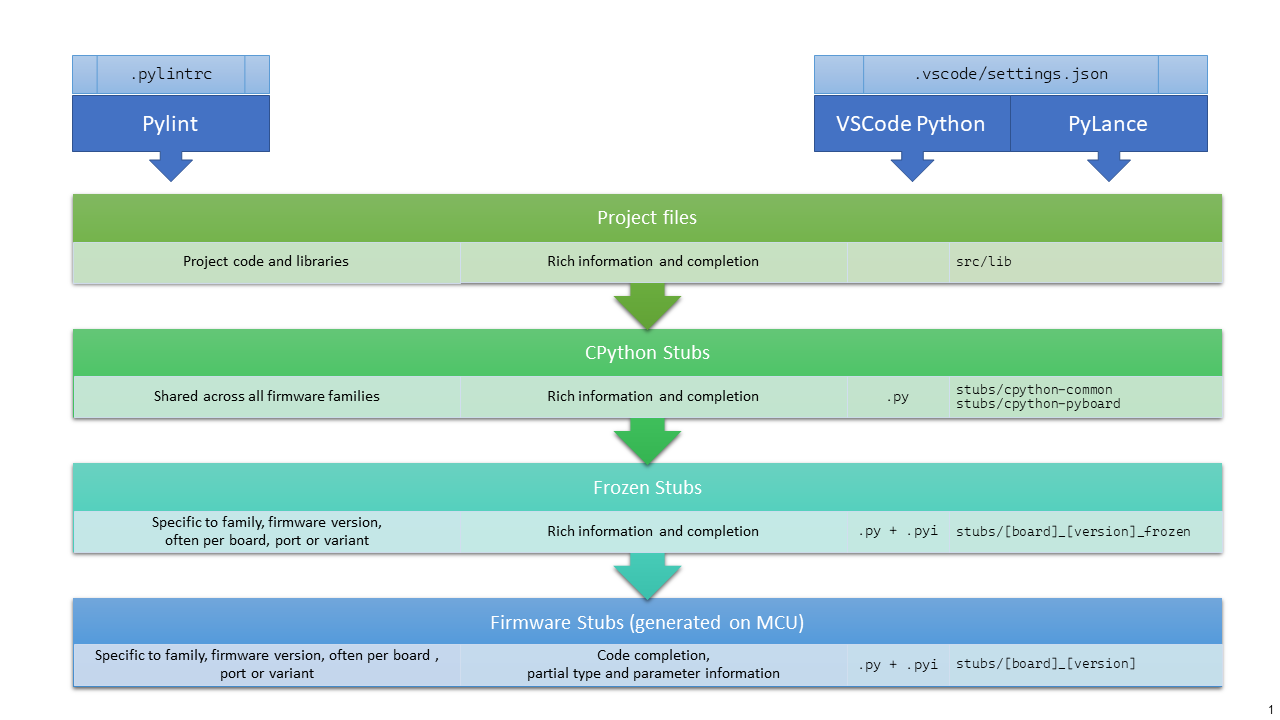Approach to collecting stub information¶
The stubs are used by 3 components.
the VSCode Pylance Language Server
the VSCode Python add-in
a linter such as pylint
These 3 tools work together to provide code completion/prediction, type checking and all the other good things. For this the order in which these tools use, the stub folders is significant, and best results are when all use the same order.
In most cases the best results are achieved by the below setup:

Your own source files, including any libraries you add to your project. This can be a single libs folder or multiple directories. There is no need to run stubber on your source or libraries.
The CPython common stubs. These stubs are handcrafted to allow MicroPython script to run on a CPython system. There are only a limited number of these stubs and while they are not intended to be used to provide type hints, they do provide valuable information. Note that for some modules (such as the
gc,timeandsysmodules) this approach does not work.Frozen stubs. Most micropython firmwares include a number of python modules that have been included in the firmware as frozen modules in order to take up less memory. These modules have been extracted from the source code.
Firmware Stubs. For all other modules that are included on the board, [micropython-stubber] or [micropy-cli] has been used to extract as much information as available, and provide that as stubs. While there is a lot of relevant and useful information for code completion, it does unfortunately not provide all details regarding parameters that the above options may provide.
Stub collection process¶
The CPython common stubs are periodically collected from the [micropython-lib][] or the [pycopy-lib][].
The Frozen stubs are collected from the repos of [micropython][] + [micropython-lib][] and from the [loboris][] repo the methods to gather these differs per firmware family , and there are differences between versions how these are stored , and retrieved. where possible this is done per port and board, or if not possible the common configuration for has been included.
the Firmware stubs are generated directly on a MicroPython board.
Firmware Stubs format and limitations¶
No function parameters are generated
No return types are generated
Instances of imported classes have no type (due to 2)
The stubs use the .py extension rather than .pyi (for autocomplete to work)
Due to the method of generation nested modules are included, rather than referenced. While this leads to somewhat larger stubs, this should not be limiting for using the stubs on a PC.
Stub naming convention¶
The firmware naming conventions is most relevant to provide clear folder names when selecting which stubs to use.
for stubfiles: {firmware family}-{version}-{port}
for frozen modules : {firmware}-{version}-frozen{port}{board}
firmware family: lowercase
micropython | loboris | pycopy | …
port: lowercase , as reported by os.implementation.platform
stm32 | esp32 | linux | win32 | rp2 | samd | …
board: used mainly for frozen stubs
GENERIC | RELEASE | UM_TINYPICO | GENERIC_512K | ARDUINO_NANO_RP2040_CONNECT | …
Note: RELEASE appears to be used mainly for CI/CD purposes and is not commonly used on hardware.
version : digits only , dots replaced by underscore, follow version in documentation rather than semver
v1_13
v1_9_4
build, only for nightly build, the build nr. extracted from the git tag
Nothing , for released versions
103
Latest